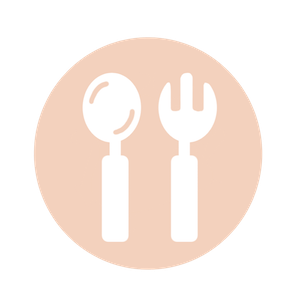Feeding
Baby health

Toddlers and young children need to eat a variety of foods to develop well. Starting exclusive with breast milk or formula, they later should get plenty of vegetables, grains, lentils, beans, some dairy, fish or meat. What they don’t need are added sugar, salty snacks, fruits juices or processed foods.
Milk and dairy products
- Breast milk: is the only food babies need in the first 6 months. After continue breastfeeding while introducing solid foods
- Infant formula: the only suitable alternative to breast milk in the first 12 months
- Whole milk and full-fat dairy products: Whole cows’ milk can be given from the age of 1. If your child has an allergy or intolerance to cow’s milk, look for alternatives
- Milk alternatives: You can give your child unsweetened milk made out of soya beans, almond or oats, from the age of 1. Children under the age of 5 should avoid rice based drinks because of high arsenic content
But beware: if young children fill up on too much on milk, they might not get the nutrients they need from other foods. These children are more likely to lack iron, which can lead to iron-deficiency anaemia and affect a child’s physical and mental development.
Fruit and vegetables
Fruit and vegetables contain a lot of vitamins, minerals and fibres. It’s good to introduce varieties from an early age. Try to make sure fruits and vegetables are included in every meal. As all fruits and vegetables contain different types of vitamins and minerals, the more varieties your child eats, the better.
Carbohydrates and starchy foods
Carbs and starchy foods, such as rice, bread, potatoes, sweet potatoes, porridge, pasta and Chinese buns provide energy, nutrients and some fibre. Whole-grains, like brown rice, provide much more nutrition than normal grains, but it’s not ideal to only give wholegrain starchy foods to under 2 year olds. Whole Grain foods can be high in fibre and they may fill up your child before they have taken in the calories and nutrients they need. After age 2 you can gradually move to a full wholegrain diet.
Proteins and iron
Young children need protein and iron to grow and develop. Iron comes in 2 forms:
- iron found in meat and fish, which is easily absorbed by the body
- iron from plant foods, which isn’t as easy for the body to absorb
Try to give your child every day 1-2 portions of beans, fish, eggs or lean meat (red meat from pigs or cows is less healthy than white meat from chicken). If your child doesn’t eat meat or fish, they can get enough iron if you give them plenty of other iron-rich foods, such as: dark green vegetables, broad beans and lentils. Nuts also contain protein, but whole nuts, including peanuts, shouldn’t be given to children under 5 as they could choke.
Fat during the first years
Young children, especially those under the age of 2, need the energy provided by fat. There are also some vitamins that are only found in fats. This is why foods like whole milk, yoghurt and oily fish, such as mackerel or salmon, are so important. Once your child is 2, you can gradually introduce lower-fat dairy products and cut down on fat in other foods, but keep an eye on the amount of saturated fats in the food your family eats. How to reduce saturated fats at home:
- Grill or bake instead of frying foods
- Reduce the amount of meat in your diet. Make up the difference with lentils, split peas or soaked dried beans
- If you eat meat, buy lean meat and during cooking, skim the fat off meat dishes such as mince or curry. Also take the skin off poultry.
- Use as little cooking oil as possible. Choose oil that’s high in mono- or polyunsaturated such as rapeseed, soya or olive oil. In some countries, oil labelled vegetable oil is often actually rapeseed oil
Sugar
It’s important to keep the amount of added sugar they have to a minimum. Added sugar is found in fizzy drinks, juice drinks, sweets, cakes and jam. It’s best to offer your toddler water or milk to drink. You can also offer diluted fruit juice (1 part juice to 10 parts water) served with meals, serving it with a meal helps to reduce the risk of tooth decay. Brushing teeth regularly is essential to help keep your child’s teeth healthy.
Salt
There’s no need to add extra salt to your child’s food. Most foods already contain enough salt and too much salt can give your child a taste for salty foods and contribute to high blood pressure in later life. Your whole family will benefit if you gradually reduce the amount of salt in your cooking. Also try to limit the amount of salty foods your child eats. As most ready-made meals, processed foods and snacks from supermarkets usually contain very high levels of unhealthy salts, you ideally skip those all together. Try to cook at home where you can ensure not too much salt was added.
Verified:
Dr. Wanwadee Sapmee Panyakat (OB-GYN), license no. 41208 (30 June 2020)



